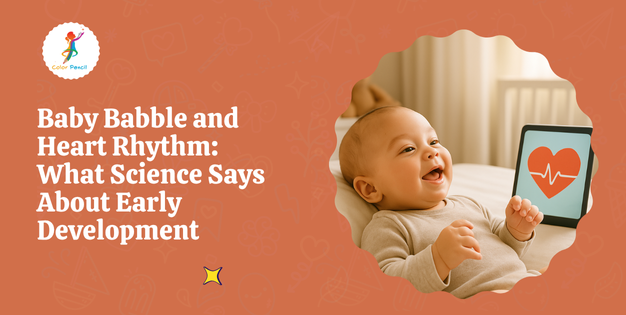
Top 10 Flashcard Combos for Holistic Toddler Learning
Did you know that up to 80% of a toddler’s brain develops in the first five years? As a parent, you’re likely eager to give

Ever wondered why your baby’s babbling sounds feel almost musical? Turns out, it’s not just cute—it might also be rhythmic. According to new research, the connection between baby babble and heart rhythm could hold the key to understanding how infants develop speech skills.
Let’s explore what this fascinating study reveals about early development—and how you can use this insight to support your baby’s growing communication abilities.

A recent study has found a surprising connection: when babies babble, their heart rhythms become more synchronized and regulated. In other words, those sweet coos and sounds may actually help babies tune their bodies as well as their voices.
Researchers observed that as infants vocalize, their heart rate stabilizes—suggesting a built-in rhythm that supports the process of learning how to speak.
So what does this mean for development?
This highlights how closely heart rate and speech growth are intertwined, even before your child speaks their first word.
The study also underscores the importance of those early sounds—cooing, gurgling, giggling. They’re not just developmental milestones; they’re practice rounds for future language skills. Babbling and cooing are crucial for language development, and the way you interact with your baby can accelerate this process. Learn how babies learn language through listening and interaction to further understand how simple conversations build early speech skills.
And get this: babies who babble more consistently tend to show stronger signs of emotional regulation and later vocabulary development.

Want to encourage more of that rhythmic babble? Here’s how:
These parental engagement babble boost strategies tell your baby: “I hear you. Keep going.”
In addition to engaging with your baby through eye contact and rhythmic music, interactive learning apps can also be a great way to foster language skills. Check out fun ways to make learning apps for kindergartners engaging and support their early vocabulary development.
Musical play is one of the best ways to reinforce both babbling and body rhythm. Add this video to your baby’s play routine:
Title: Rhymes with Musical Instruments | Baby’s First Band Songs for Toddlers | Color Pencil TV
With fun instruments and playful rhymes, this video helps infants explore sound, timing, and expression—ideal for supporting early language development and syncing sound with emotion.
Babble is your baby’s first conversation.
When you respond to it, you’re teaching your baby that their voice matters. And that emotional feedback? It’s what keeps their heart—and their language—growing in rhythm.

Feeling Overwhelmed? Let’s Talk! Join Our Parent Forum and Get Expert Advice & Support!
Studies show babies’ heart rates become more stable during babbling, which may help regulate speech timing and emotional states.
Rhythm helps babies develop timing, pacing, and syllable control—all key for language learning.
Cooing and babbling are early signs of vocal development and brain engagement with language sounds.
Talking, singing, making eye contact, and responding to your baby’s sounds all help boost their babbling.
Absolutely. Musical play promotes listening, timing, and expressive language—especially when paired with movement or facial interaction.